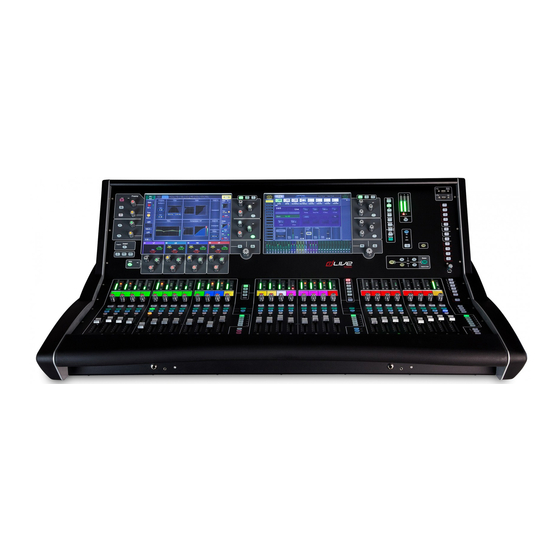
Summarization of Contents
Limited One Year Manufacturer's Warranty
Conditions Of Warranty
Details the conditions under which the warranty is void or valid, including misuse, alteration, and authorized repair.
IMPORTANT - Read Before Starting
Safety Instructions
Emphasizes reading safety instructions printed with the equipment for user and performer safety.
System Operating Firmware
Explains that dLive Surface functionality depends on firmware and advises checking for the latest version.
General Precautions
Lists precautions for protecting the equipment from damage, extreme conditions, and improper handling.
Further Information & Registration
Guides users to website resources and product registration for support and updates.
1. Introduction
1.1 dLive Surfaces
Describes the three sizes of dLive Surfaces and their key features.
2. Rear Panel Connectors
Mic/Line and Digital Inputs
Explains mic/line preamps, phantom power, and stereo AES3 digital inputs.
Line and Digital Outputs
Details balanced XLR line outputs and stereo AES3 digital outputs.
I/O Ports and Status Indicators
Details expansion ports for option cards and explains system status indicators.
Kensington Lock and Power Supply
Network Ports
Describes the 2 RJ45 Gigabit Ethernet ports for connecting to dLive Editor or iOS apps.
gigaACE Link Connection
Explains the MixRack to Surface link over Gigabit Ethernet for audio and control, with redundancy.
DX Links and Word Clock I/O
USB and Screen Out Ports
Explains USB port for file transfer/updates and VGA port for external monitor connection.
3. Front Panel Overview
Channel Processing and Touchscreen
Instructs on accessing processing via Sel keys and describes the capacitive touchscreen interface.
Meters and USB Ports
Explains LCR meters with PAFL indicator and details the two USB ports for recording/playback and data transfer.
Front Panel Controls
SoftKeys and Talkback
Explains the 26 user-assignable SoftKeys and the Talkback button functionality.
Home and Scene Navigation
Details how to use Home to reset settings and navigate through scenes.
Strip Rotary Mode and Layers
Explains control functions of strip rotaries and navigating fader strip layers.
Safes and Phones
Explains how to make channels safe from recall and details headphone jack sockets.
Fader Strip Operations
Fader Strip Controls
Explains the function of fader strips for controlling channels, FX, masters, and editing strip layout.
Copy, Paste, and Reset Functions
Describes how to copy, paste, and reset channel processing, mix assignments, and block settings.
Assign and Pre/Post Settings
Explains how to toggle channel assignment to the active Mix and set pre/post fade sends.
LCD Display Mode
Details how to select information displayed on the strip LCDs.
Harmony UI - Processing Screen Elements
Preamp, Filters, and Insert
Details preamp controls, filter settings (HPF/LPF), and channel insert functionality.
Library Access and PEQ
Explains how to access the preset library and control the parametric equalizer (PEQ).
Touch & Turn, Help, and Soft Rotaries
Describes parameter adjustment with rotary controls, context-sensitive help, and assignable soft rotaries.
Harmony UI - System Screen Elements
Widget Areas and Rotary Control
Explains configuration of widget areas for functions and adjustment using the rotary control.
Soft Rotaries and Screen Modes
Describes assignable soft rotaries and selecting various screen modes for system operation.
3.3 Fader Strip
Meter and LCD Display
Describes the signal meter, gain reduction meter, peak indicators, and information on the channel LCD.
Strip Rotary and Mute Function
Details the function of strip rotaries and how to mute a channel signal.
Sel, Mix, and PAFL Functions
Explains channel selection, mix assignments, and the PAFL monitoring function.
3.4 Working with the Mix
Normal Mix Mode (FOH)
Describes the standard mixing mode where input strips show channel faders and master strips show mix faders.
Master Mix and Channel Mix Views
Explains using these views for Aux/FX sends and managing pre/post fader settings.
DCA and Audio Group Assignment
Explains how to assign channels to Audio and DCA groups for organized control.
4. Connect and Power Up
MixRack and Expander Connections
Details connecting the dLive Surface to the MixRack and DX Expanders using CAT5e cables and powering sequence.
Recalling a Template Show
Explains how to load template shows for a starting point and the effect of recalling a show.
6. Technical Specifications
Input and Output Specifications
Details specifications for mic/line inputs, digital inputs, analogue outputs, and digital outputs.
System, USB Audio, and Power
Lists system specs, USB audio capabilities, and mains voltage/power consumption details.
Temperature and Dimensions
Specifies operating temperature range and provides dimensions and weights for all models.
















Need help?
Do you have a question about the Olive S7000 and is the answer not in the manual?
Questions and answers